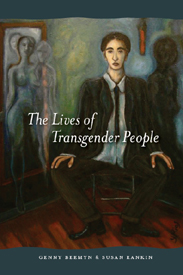
The diversity of transgender people is shown through the results of the author’s online survey of 3,474 participants between November 2005, and February 2006, the most comprehensive survey to date. Using a design to gather data not previously sought, the authors made every effort to include people who identify outside the usual binary gender assignments.
They group respondents into four categories: “female-to-male/transgender, male-to-female/transgender, female-to-different-gender, and male-to-different-gender.” Overall, the female-to-male/transgender respondents and those who identify as genderqueer were younger than those who identify as cross-dressers or male-to-female/transgender.
Discussions of gender always struggle with language. This difficulty is particularly evident when respondents try to categorize their sexual orientation. According to the authors, “throughout the book, we use a number of terms and concepts with highly contested and unstable definitions.” They also use gender neutral pronouns rather than the circumlocutions that have popularly replaced the generic masculine. At birth, sex is assigned by a doctor based on the presence or absence of a visible penis: “gender assignment is thus medicalized, phallocentric, and dichotomous.”
In asking about genderism, transphobia, and gender bashing, the authors learned that harassment and discrimination rates, as well as the likelihood of violence, are much higher for people of color who are gender variant. “Genderism is the negative cultural ideology, gender prejudice is the emotional expression of that ideology, and gender bashing is the violent manifestation of those emotions.” Their research provides justification for more inclusive hate crime laws. According to a study by Genderpac, “homicides classified as hate crimes were about one-and-a-half times more likely (50 versus 33 percent) to result in the apprehension of a suspect.”
Earlier studies tended to lump together all transgender people and to view them in sequential stages of “becoming.” The survey shows that similar events are experienced differently by persons who identify as female-to-male transgender, male-to-female transgender, cross-dresser, or genderqueer. The authors emphasize the importance of not defining people by surgeries.
Despite the much wider availability of information about transgenderism, many of those under age 23 do not find it any easier to accept that they are transgender. In general, children who are labeled male experience more pressure to conform to gender expectations and therefore may become aware of their gender difference earlier. Children labeled female are often able to behave in ways that fit their internal gender, at least until puberty.
Those who identify as genderqueer, or as some other non-binary gender, sometimes encounter hostility within the LGBT community, as well as struggles in a society that presumes there are only two choices on everything from forms to sports. Of particular interest was the discovery of how higher education can become more welcoming. College campuses that have taken a step toward inclusivity, such as offering domestic partner benefits, are more likely to have LGBT individuals willing to come out and to report any harassment.
Unfortunately, survey participants did not include significant numbers of transgender people in the military or blue-color work. Otherwise, this research will be valuable for agencies that provide services to transgender people, whether the organization’s focus or simply part of the population served. The book would not be a first choice for someone needing basic information about what it means to be transgender.
Reviewer: Carolyn Caywood, Retired
Virginia Beach Public Library